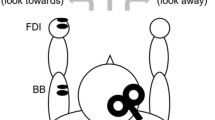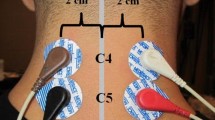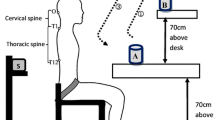Abstract
The objective of this study was to compare onset of deep and superficial cervical flexor muscle activity during rapid, unilateral arm movements between ten patients with chronic neck pain and 12 control subjects. Deep cervical flexor (DCF) electromyographic activity (EMG) was recorded with custom electrodes inserted via the nose and fixed by suction to the posterior mucosa of the oropharynx. Surface electrodes were placed over the sternocleidomastoid (SCM) and anterior scalene (AS) muscles. While standing, subjects flexed and extended the right arm in response to a visual stimulus. For the control group, activation of DCF, SCM and AS muscles occurred less than 50 ms after the onset of deltoid activity, which is consistent with feedforward control of the neck during arm flexion and extension. When subjects with a history of neck pain flexed the arm, the onsets of DCF and contralateral SCM and AS muscles were significantly delayed (p<0.05). It is concluded that the delay in neck muscle activity associated with movement of the arm in patients with neck pain indicates a significant deficit in the automatic feedforward control of the cervical spine. As the deep cervical muscles are fundamentally important for support of the cervical lordosis and the cervical joints, change in the feedforward response may leave the cervical spine vulnerable to reactive forces from arm movement.



Similar content being viewed by others
References
Aruin AS, Latash ML (1995) Directional specificity of postural muscles in feed-forward postural reactions during fast voluntary arm movements. Exp Brain Res 103:323–332
Bouisset S, Zattara M (1981) A sequence of postural adjustments precedes voluntary movement. Neurosci Lett 22:263–270
Conley MS, Meyer RA, Bloomberg JJ, Feeback DL, Dudley GA (1995) Noninvasive analysis of human neck muscle function. Spine 20:2505–2512
Falla D, Dall’Alba P, Rainoldi A, Merletti R, Jull G (2002) Identification of innervation zones of sternocleidomastoid and scalene muscles: a basis for clinical and research electromyography applications. Clin Neurophysiol 113:57–63
Falla D, Jull G, Dall’Alba P, Rainoldi A, Merletti R (2003) An electromyographic analysis of the deep cervical flexor muscles during cranio-cervical flexion. Phys Ther 83:899–906
Falla D, Jull G, Hodges P (2004a) Neck pain patients demonstrate reduced activation of the deep neck flexor muscles during performance of the cranio-cervical flexion test. Spine (in press)
Falla D, Rainoldi A, Merletti R, Jull G (2004b) Spatio-temporal evaluation of neck muscle activation during postural perturbations. J Electromyogr Kinesiol (in press)
Gurfinkel VS, Lipshits MI, Lestienne FG (1988) Anticipatory neck muscle activity associated with rapid arm movements. Neurosci Lett 94:104–108
Heikkila H, Astrom P (1996) Cervicocephlic kinesthetic sensibility in patients with whiplash injury. Scand J Rehabil Med 28:133–138
Hodges PW, Richardson CA (1996) Inefficient muscular stabilization of the lumbar spine associated with low back pain. A motor control evaluation of transversus abdominis. Spine 21:2640–2650
Hodges PW, Richardson CA (1997a) Feedforward contraction of transversus abdominis is not influenced by the direction of arm movement. Exp Brain Res 114:362–370
Hodges PW, Richardson CA (1997b) Relationship between limb movement speed and associated contraction of the trunk muscles. Ergonomics 40:1220–1230
Hodges PW, Richardson CA (1999) Altered trunk muscle recruitment in people with low back pain with upper limb movement at different speeds. Arch Phys Med Rehabil 80:1005–1012
Jull GA (2000) Deep cervical flexor muscle dysfunction in whiplash. J Musculoskel Pain 8:143–154
Jull G, Trott P, Potter H, Zito G, Niere K, Shirley D, Emberson J, Marschner I, Ricardson C (2002) A randomized controlled trial of exercise and manipulative therapy for cervicogenic headache. Spine 27:1835–1843
Keshner EA, Woollacott MH, Debu B (1988) Neck, trunk and limb muscle responses during postural perturbations in humans. Exp Brain Res 71:455–466
Lang J (1993) Clinical anatomy of the cervical spine. Thieme Medical, New York
Mayoux-Benhamou MA, Revel M, Vallee C, Roudier R, Barbet JP, Bargy F (1994) Longus colli has a postural function on cervical curvature. Surg Radiol Anat 16:367–371
McKenzie DK, Gandevia SC (1985) Phrenic nerve conduction times and twitch pressures of the human diaphragm. J Appl Physiol 58:1496–1504
McPartland JM, Brodeur RR, Hallgren RC (1997) Chronic neck pain, standing balance, and suboccipital muscle atrophy—a pilot study. J Manipulative Physiol Ther 20:24–29
Nannucci L, Merlo A, Merletti R, Rainoldi A, Bergamo R, Melchiorri G, Lucchetti D, Caruso I, Falla D, Jull G (2002) Atlas of the innervation zones of upper and lower extremity muscles. In: Proceedings of XIV Congress of the International Society of Electrophysiology and Kinesiology, Vienna, pp 353–354
van der Fits IBM, Kilp AWJ, van Eykern LA, Hadders-Algra M (1998) Postural adjustments accompanying fast pointing movements in standing, sitting and lying adults. Exp Brain Res 120:202–216
Vasavada AN, Li S, Delp SL (1998) Influence of muscle morphometry and moment arms on the moment-generating capacity of human neck muscles. Spine 23:412–422
Vernon H, Mior S (1991) The Neck Disability Index: a study of reliability and validity. J Manipulative Physiol Ther 14:409–415
Winters JM, Peles JD (1990) Neck muscle activity and 3D head kinematics during quasistatic and dynamic tracking movements. In: Winters JM, Woo SL-Y (eds) Multiple muscle systems: biomechanics and movement organisation. Springer-Verlag, Berlin Heidelberg New York, pp 461–480
Acknowledgements
This study was supported by a University of Queensland Small Grant and grants received from the Centre of National Research on Disability and Rehabilitation Medicine (CONROD; Australia) and Suncorp Metway General Insurance. Paul Hodges was supported by the NHMRC of Australia.
Author information
Authors and Affiliations
Corresponding author
Rights and permissions
About this article
Cite this article
Falla, D., Jull, G. & Hodges, P.W. Feedforward activity of the cervical flexor muscles during voluntary arm movements is delayed in chronic neck pain. Exp Brain Res 157, 43–48 (2004). https://doi.org/10.1007/s00221-003-1814-9
Received:
Accepted:
Published:
Issue Date:
DOI: https://doi.org/10.1007/s00221-003-1814-9




